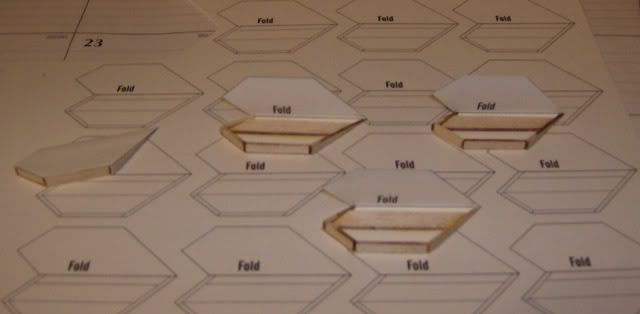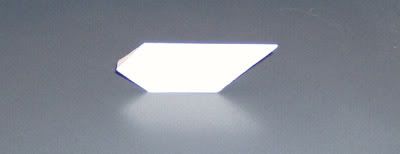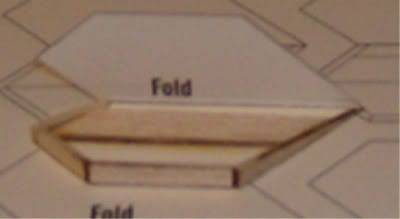The fins are very lightweight, both in mass and in construction. As shown in the original instructions, you build a frame around the outside edges of one side of the folded cardstock skin, then fold the other side over and glue it to the frame. Carl's tight laser cuts a clean line for these pieces, and the wedge-shaped pieces are accurate, but the pieces themselves don't quite fill up the gaps at the corners. The long straight piece is a tad short; meaning you wind up with two pieces of balsa just barely touching on the inside corners, and a big gap to fill on the outside corner. A better fit could be achieved if the long piece was about a 16th inch longer, and bevels were sanded into the ends to meet the short straight piece and the root-edge long wedge.
A second issue is a product of the overall frame design. The large central piece of balsa that ties the frame together between the wedges is glued to the skin on one side only. This leaves one whole skin side unsupported, and thus allows for acceleration-induced collapsing of the skin during launch. On a high-power "C" launch, this could lead to a vectoring of the slipstream by the fin shape, causing a roll in one direction. While this may not be a big issue, and the resulting spin may add some stability to the model, I think in a future build I might have to use a thicker piece, like 3/32" or even 1/8", and sand it to a matching wedge shape before fitting it into the frame. This would allow both skins to have contact with this member and the fin would retain its shape better.
These issues are simply a result of following the original version closely, and not a criticism of Carl or his work. These issues existed in the original kit 37 years ago, and they remain today.
First image shows the four fins together, one completed:

Here's the assembled fin, all nicely closed up:

Here's one of the still-open fins, showing the frame gaps:

In this last image (sorry for the blur -- inside shooting, flash, low-light, close proximity...) you can see how the large member fits against one side of the fin but doesn't touch the other. The skin on this side is supported solely around the edges. This piece needs to be thicker, and sanded to match the wedges. Doing this will allow the skin to be supported along the center.
I used full-strength Titebond II applied with a small artist's brush. Lay down a thin layer onto the skin first, then apply a layer to the wood piece before setting it in place. The full-strength glue has the "tack" you need to hold things in position.
You will note the fins are sitting on a full sheet of skin images. After building the first fin with thinned glue, I found the moisture deformed the skin too much. I wound up having to cut new pieces from scratch for one fin, and needed at least one fresh skin to finish the work.
Next: Attaching things to the body...